Try It
Reading Graphs Practice: Single Shifts and Simultaneous Shifts
For each of the following graphs, determine what happens to Equilibrium Price and Equilibrium Quantity when the curve shifts to D2, S2 or both.
Hints:
- Watch Demonstrating Graphing Equilibrium with One Shift for help with Graphs A - D.
- Watch Demonstrating Graphing Equilibrium with Simultaneous Shifts for help with Graphs E - H.
- Remember: Left curves shifts = less. Right curve shifts = more.
- Determine what happens to Equilibrium Price and Equilibrium Quantity when the curve shifts to D2.
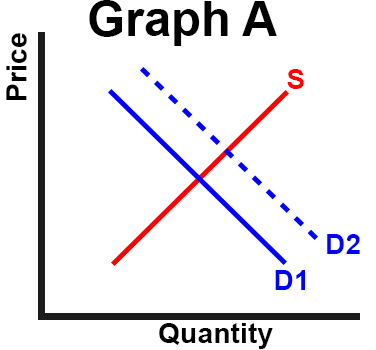
See larger version of Graph A here. - The New Equilibrium Price: Locate the new Equilibrium by identifying the intersection of the dotted lines. Identify the correct answer that describes the new Equilibrium Price.
- Increases ↑
- Decreases ↓
- Indeterminate
- The Equilibrium Quantity: Locate the new Equilibrium by identifying the intersection of the dotted lines. Identify the correct answer that describes the new Equilibrium Quantity.
- Increases ↑
- Decreases ↓
- Indeterminate
Answer: a. new equilibrium price increases and b. new equilibrium quantity increases.
- The New Equilibrium Price: Locate the new Equilibrium by identifying the intersection of the dotted lines. Identify the correct answer that describes the new Equilibrium Price.
- Determine what happens to Equilibrium Price and Equilibrium Quantity when the curve shifts to D2.
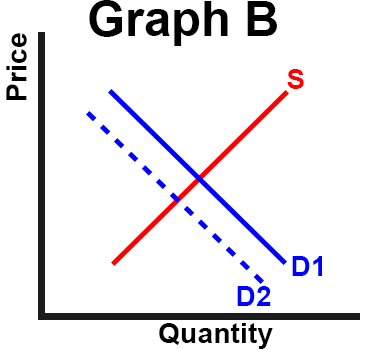
See larger version of Graph B here. - The New Equilibrium Price: Locate the new Equilibrium by identifying the intersection of the dotted lines. Identify the correct answer that describes the new Equilibrium Price.
- Increases ↑
- Decreases ↓
- Indeterminate
- The Equilibrium Quantity: Locate the new Equilibrium by identifying the intersection of the dotted lines. Identify the correct answer that describes the new Equilibrium Quantity.
- Increases ↑
- Decreases ↓
- Indeterminate
Answer: a. new equilibrium price decreases and b. new equilibrium quantity decreases.
- The New Equilibrium Price: Locate the new Equilibrium by identifying the intersection of the dotted lines. Identify the correct answer that describes the new Equilibrium Price.
- Determine what happens to Equilibrium Price and Equilibrium Quantity when the curve shifts to S2.
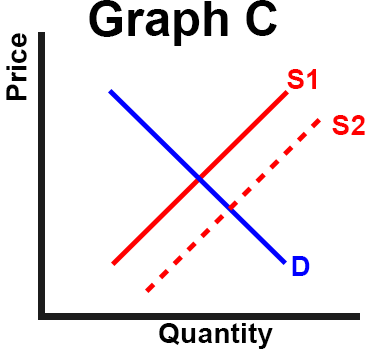
See larger version of Graph C here. - The New Equilibrium Price: Locate the new Equilibrium by identifying the intersection of the dotted lines. Identify the correct answer that describes the new Equilibrium Price.
- Increases ↑
- Decreases ↓
- Indeterminate
- The Equilibrium Quantity: Locate the new Equilibrium by identifying the intersection of the dotted lines. Identify the correct answer that describes the new Equilibrium Quantity.
- Increases ↑
- Decreases ↓
- Indeterminate
Answer: a. new equilibrium price decreases and b. new equilibrium quantity increases.
- The New Equilibrium Price: Locate the new Equilibrium by identifying the intersection of the dotted lines. Identify the correct answer that describes the new Equilibrium Price.
- Determine what happens to Equilibrium Price and Equilibrium Quantity when the curve shifts to S2.
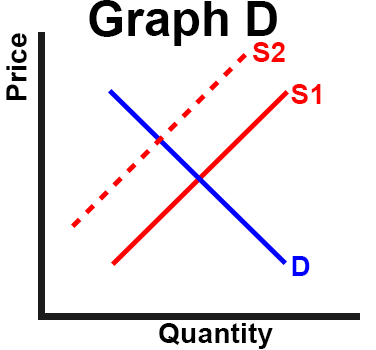
See larger version of Graph D here. - The New Equilibrium Price: Locate the new Equilibrium by identifying the intersection of the dotted lines. Identify the correct answer that describes the new Equilibrium Price.
- Increases ↑
- Decreases ↓
- Indeterminate
- The Equilibrium Quantity: Locate the new Equilibrium by identifying the intersection of the dotted lines. Identify the correct answer that describes the new Equilibrium Quantity.
- Increases ↑
- Decreases ↓
- Indeterminate
Answer: a. new equilibrium price increases and b. new equilibrium quantity decreases.
- The New Equilibrium Price: Locate the new Equilibrium by identifying the intersection of the dotted lines. Identify the correct answer that describes the new Equilibrium Price.
- Determine what happens to Equilibrium Price and Equilibrium Quantity when the curves shift to both S2 and D2.
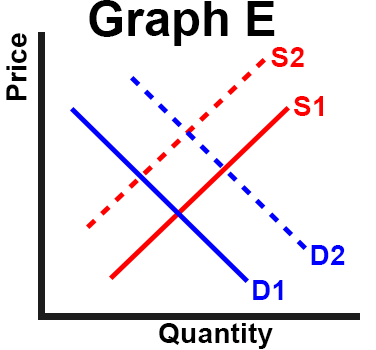
See larger version of Graph E here. - The New Equilibrium Price: Locate the new Equilibrium by identifying the intersection of the dotted lines. Identify the correct answer that describes the new Equilibrium Price.
- Increases ↑
- Decreases ↓
- Indeterminate
- The Equilibrium Quantity: Locate the new Equilibrium by identifying the intersection of the dotted lines. Identify the correct answer that describes the new Equilibrium Quantity.
- Increases ↑
- Decreases ↓
- Indeterminate
Answer: a. new equilibrium price increases and b. new equilibrium quantity is indeterminate.
- The New Equilibrium Price: Locate the new Equilibrium by identifying the intersection of the dotted lines. Identify the correct answer that describes the new Equilibrium Price.
- Determine what happens to Equilibrium Price and Equilibrium Quantity when the curves shift to both S2 and D2.

See larger version of Graph F here. - The New Equilibrium Price: Locate the new Equilibrium by identifying the intersection of the dotted lines. Identify the correct answer that describes the new Equilibrium Price.
- Increases ↑
- Decreases ↓
- Indeterminate
- The Equilibrium Quantity: Locate the new Equilibrium by identifying the intersection of the dotted lines. Identify the correct answer that describes the new Equilibrium Quantity.
- Increases ↑
- Decreases ↓
- Indeterminate
Answer: a. new equilibrium price decreases and b. new equilibrium quantity is indeterminate.
- The New Equilibrium Price: Locate the new Equilibrium by identifying the intersection of the dotted lines. Identify the correct answer that describes the new Equilibrium Price.
- Determine what happens to Equilibrium Price and Equilibrium Quantity when the curves shift to both S2 and D2.
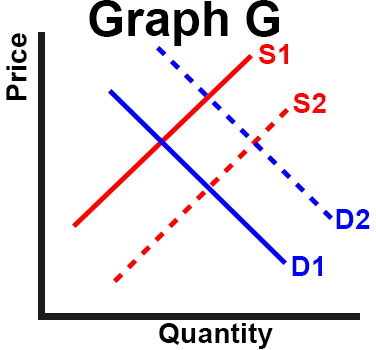
See larger version of Graph G here. - The New Equilibrium Price: Locate the new Equilibrium by identifying the intersection of the dotted lines. Identify the correct answer that describes the new Equilibrium Price.
- Increases ↑
- Decreases ↓
- Indeterminate
- The Equilibrium Quantity: Locate the new Equilibrium by identifying the intersection of the dotted lines. Identify the correct answer that describes the new Equilibrium Quantity.
- Increases ↑
- Decreases ↓
- Indeterminate
Answer: a. new equilibrium price is indeterminate and b. new equilibrium quantity increases.
- The New Equilibrium Price: Locate the new Equilibrium by identifying the intersection of the dotted lines. Identify the correct answer that describes the new Equilibrium Price.
- Determine what happens to Equilibrium Price and Equilibrium Quantity when the curves shift to both S2 and D2.

See larger version Graph H here. - The New Equilibrium Price: Locate the new Equilibrium by identifying the intersection of the dotted lines. Identify the correct answer that describes the new Equilibrium Price.
- Increases ↑
- Decreases ↓
- Indeterminate
- The Equilibrium Quantity: Locate the new Equilibrium by identifying the intersection of the dotted lines. Identify the correct answer that describes the new Equilibrium Quantity.
- Increases ↑
- Decreases ↓
- Indeterminate
Answer: a. new equilibrium price is indeterminate and b. new equilibrium quantity decreases.
- The New Equilibrium Price: Locate the new Equilibrium by identifying the intersection of the dotted lines. Identify the correct answer that describes the new Equilibrium Price.
You've completed this review activity!